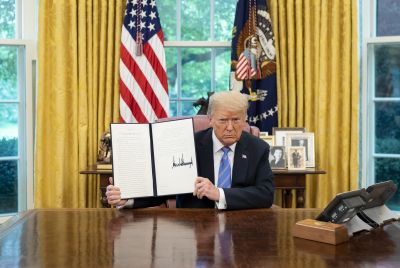How To Check If You're Qualified For Stimulus Payment For November 2025 - But First, Is This Happening?
The Supreme Court heard oral arguments on the legality of President Trump's tariffs under the International Emergency Economic Powers Act on 5 November 2025

As inflation bites and household budgets strain in late 2025, President Donald Trump has floated a £1,520 ($2,000) tariff dividend payment, igniting viral searches for Trump stimulus check 2025 and $2000 tariff payment.
On 10 November 2025, amid Supreme Court tariff battles, Trump promised this rebate from import duties to middle and low earners, fuelling trends like stimulus eligibility 2025 and tariff rebate checks.
Yet, with Congress's approval required and no bill advancing, sceptics question if this November 2025 rebate will materialise or join unfulfilled pledges in economic relief 2025.
Is the $2,000 Tariff Dividend Proposal Real?
President Donald Trump affirmed on 10 November 2025 in the Oval Office, 'We're going to issue a dividend to our middle income people and lower-income people of about $2,000 and we're going to use the remaining tariffs to lower our debt, which is a national security thing.' This aligns with his 9 November 2025 Truth Social declaration: 'A dividend of at least $2000 a person (not including high income people!) will be paid to everyone.'
Tariffs, authorised under a 1977 emergency law, are forecast to generate £195 billion ($300 billion) annually, per fiscal estimates. Yet, the Committee for a Responsible Federal Budget projects a universal £1,303 ($2,000) distribution would cost £391 billion ($600 billion) yearly—twice the intake—exacerbating deficits.
Senator Josh Hawley introduced the American Worker Rebate Act in July 2025, aiming to deliver at least £391 ($600) from tariffs to qualifying workers, but it stalled in the Senate Finance Committee. Treasury Secretary Scott Bessent, appearing on ABC's 'This Week' on 9 November 2025, tempered expectations: 'I haven't spoken to the president about this yet, but... it could be just the tax decreases... no tax on tips, no tax on overtime.'
The Supreme Court heard arguments on 5 November 2025 regarding tariff legality; a ruling against the administration could compel refunds of billions, sabotaging the scheme. Northeastern analysts warned on 10 November 2025 of potential inflation surges, advocating congressional oversight. Axios highlighted on 10 November 2025 how the idea revives pandemic relief but faces fiscal barriers.
Understanding Stimulus Eligibility for Tariff Rebates
Qualification for stimulus eligibility likely echoes prior programmes, with full £1,521 ($2,000) for individuals under £57,600 ($75,000) adjusted gross income and families below £116,100 ($150,000). Trump's exclusion of high earners targets middle and lower incomes.
To verify, access the IRS online account for tax records and past payment history, essential for confirming eligibility thresholds. Bloomberg indicates U.S. citizens or permanent residents, non-dependents, qualify primarily.
CNN notes dependent adjustments could add per child. Gather 2024 returns now; monitor IRS announcements for tariff rebate specifics. Proactive IRS portal use positions recipients for any rollout.
Potential Impacts: Affordability Relief Versus Inflation Concerns
The tariff dividend offers affordability crisis alleviation, with Northeastern economists estimating net £380 ($500)–£532 ($700) household gains post-tariff costs. It could spur spending despite Trump tariffs hiking import prices. Yet, Forbes cautions £456 billion ($600 billion) influx may exacerbate inflation from tariffs, challenging Fed policy.
The Washington Post highlights fiscal hurdles, as costs double revenue, diverting debt paydown. On X, Paul Barron observed, 'Average household tariff cost: $1,300-$1,500/year Proposed stimulus check: $2,000 Net benefit: $500-$700 for most families.'
🚨 Trump floats $2,000 stimulus checks funded by tariff revenue
— PaulBarron (@paulbarron) October 2, 2025
Opportunity or Rebate: Tariffs Are Already Costing American Households Money.
The cost breakdown:
Average household tariff cost: $1,300-$1,500/year
Proposed stimulus check: $2,000
Net benefit: $500-$700 for most…
Axios views it as unexecuted rhetoric. Short-term relief weighs against long-term strains. The Supreme Court heard oral arguments on the legality of President Trump's tariffs under the International Emergency Economic Powers Act on 5 November 2025, with no ruling issued yet and a decision anticipated in mid-2026, potentially affecting the proposal's viability; track updates via official IRS channels for any fiscal implications.
© Copyright IBTimes 2025. All rights reserved.




















